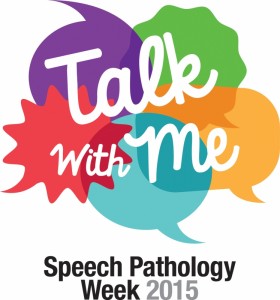 Talking with your child as you share books together is shown time and time again to be one of the most important things you can do to help your child develop literacy skills. There are many things families can do at home to help their child be successful with literacy. You, as a parent, are the most important influence on your child’s learning. Here are some things you can do to help your child’s language and literacy develop. You can begin before your child starts school and continue on as your child develops their skills in literacy.
Talking with your child as you share books together is shown time and time again to be one of the most important things you can do to help your child develop literacy skills. There are many things families can do at home to help their child be successful with literacy. You, as a parent, are the most important influence on your child’s learning. Here are some things you can do to help your child’s language and literacy develop. You can begin before your child starts school and continue on as your child develops their skills in literacy.
1. Read, Read, Read! Make a habit of reading to your child every day. Reading to your child is the one thing that has the biggest impact on your child’s ability to learn to read. When you start reading to your child at an early age, your child grows up with reading as an enjoyable part of their daily routine. Mem Fox, author and educator, believes that children need to hear 1000 books before they begin to read themselves. This is easy if you begin when your child is a baby, but much harder if you wait until they begin school.
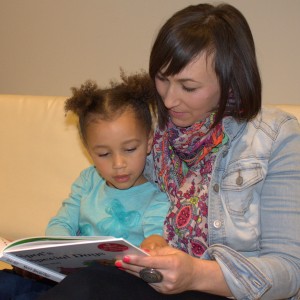 2. Re-read favourites. Mem Fox suggests sharing three books with your child each day; a new one, one you have read before and an old favourite that your child has heard many, many times. Children learn through repetition. Hearing a story a number of times allows your child to understand the story, link the words to the pictures, understand the rhythm and flow of the words and predict what comes next. Prediction is a skill used by fluent readers. Help your child learn to predict by giving them a chance to fill in words as you read familiar stories.
2. Re-read favourites. Mem Fox suggests sharing three books with your child each day; a new one, one you have read before and an old favourite that your child has heard many, many times. Children learn through repetition. Hearing a story a number of times allows your child to understand the story, link the words to the pictures, understand the rhythm and flow of the words and predict what comes next. Prediction is a skill used by fluent readers. Help your child learn to predict by giving them a chance to fill in words as you read familiar stories.
3. Explore a range of texts. Stories are great but there are lots of other things to explore too, such as magazines, letters, postcards, menus, newspapers, newsletters, advertisements, signs, brochures, notes, shopping lists, birthday and Christmas cards, recipes, diaries, instructions, maps, even bills. Share all these different reading and writing experiences with your child and talk about them together.
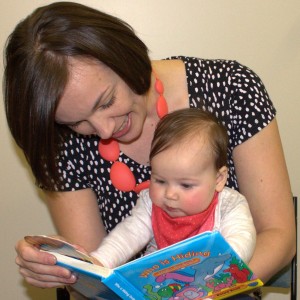 4. Talk, talk, talk! Reading and writing are language skills so strong language skills mean it is easier to develop literacy. Talk to your child as much as you can in your daily activities together. Vocabulary (the number of words your child understands and uses) is particularly important. The biggest difference between good and poor readers is the size of their vocabulary. Looking at books and talking about them is a great way to develop vocabulary and help your child learn words they may not come across in daily life.
4. Talk, talk, talk! Reading and writing are language skills so strong language skills mean it is easier to develop literacy. Talk to your child as much as you can in your daily activities together. Vocabulary (the number of words your child understands and uses) is particularly important. The biggest difference between good and poor readers is the size of their vocabulary. Looking at books and talking about them is a great way to develop vocabulary and help your child learn words they may not come across in daily life.
5. Talk about how books work. Help your child learn about books. Talk about the cover, how to hold the book and turn the pages, the title and how it gives clues to what is inside. Talk about the pictures and how the words tell about the pictures. Show how you start a book on the first page and work towards the end and how you start a page and read top to bottom and left to right. Look at lots of different books. Try making your own books. Help your child to feel confident around books.
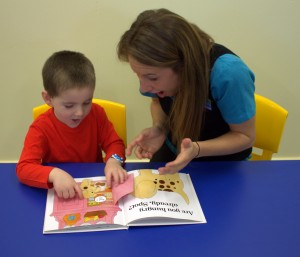 6. Talk about sounds. Talk about the sounds your child hears as a part of their life. Sing songs, tell rhymes and listen to music and stories on CD. Talk about the sounds in words. Clap out syllables and count them, talk about long words and short words. Read rhyming stories and talk about how rhyming words sound the same. Have fun making up your own rhymes. Talk about the sounds in your child’s name. Talk about beginning and ending sounds in words and match things with the same sounds. Break up words into separate sounds. Play I spy.
6. Talk about sounds. Talk about the sounds your child hears as a part of their life. Sing songs, tell rhymes and listen to music and stories on CD. Talk about the sounds in words. Clap out syllables and count them, talk about long words and short words. Read rhyming stories and talk about how rhyming words sound the same. Have fun making up your own rhymes. Talk about the sounds in your child’s name. Talk about beginning and ending sounds in words and match things with the same sounds. Break up words into separate sounds. Play I spy.
7. Talk about words and letters. Look at words everywhere and talk about them. Count the letters in words and talk about long and short words. Talk about the sounds that letters make. Look at alphabet books and help your child to understand the name and the sound of the letter such as “B” is called “bee” and it makes a “buh” sound. Cut letters out of magazines and paste them. Make your own alphabet book. Find the letter your child’s name starts with any where you can. Look at common words and see if you can find them on the pages of a book. Show your child that a word such as “the” has the same letters each time you find it and look for it in different places.
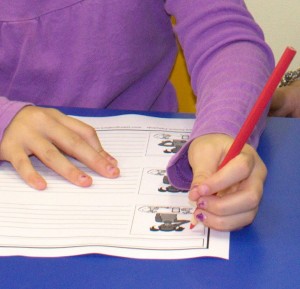 8. Talk about stories. Talk about how stories have a beginning and ending and how people in stories often have a problem to solve. Talk about the way that, in stories, we need to tell who is talking by using something like “he said”. Talk about how the end of a story often has feeling words. Retell stories from the pictures. Make up your own stories.
8. Talk about stories. Talk about how stories have a beginning and ending and how people in stories often have a problem to solve. Talk about the way that, in stories, we need to tell who is talking by using something like “he said”. Talk about how the end of a story often has feeling words. Retell stories from the pictures. Make up your own stories.
9. Talk about what you read. When you read together, talk to your child about what you read to develop their comprehension. Talk about what is happening, what you think about the characters, how they are feeling, what they might think, what they might do, what you would do, what might happen next.
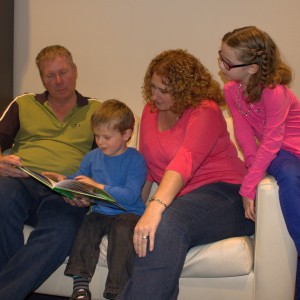 10. Make reading, writing and talking together a part of your family life. Let your child see you read and write in lots of different ways and talk about what you are doing. Involve them in activities such as opening the mail, writing letters, cards, and lists. Make sure your child has lots of chances through the day to use books, pencils, paper, drawing and writing materials. Join your local library and visit as a family. Show interest and pleasure in your child’s attempts to read and write, talk together about them and put their writing and drawings on display.
10. Make reading, writing and talking together a part of your family life. Let your child see you read and write in lots of different ways and talk about what you are doing. Involve them in activities such as opening the mail, writing letters, cards, and lists. Make sure your child has lots of chances through the day to use books, pencils, paper, drawing and writing materials. Join your local library and visit as a family. Show interest and pleasure in your child’s attempts to read and write, talk together about them and put their writing and drawings on display.
If you are concerned about your child's development including speech, language, play skills, social communication skills, social skills or learning check our website to see how Talking Matters may be able to help. For more ideas and resources check the resources section on our website and our extensive Pinterest page. Like us on Facebook and follow us on Twitter so you don't miss out on what's happening.
Related Blog Posts
If you liked this post you may also like:
Answering Questions
ASD: Think and feel
15 ASD homework tips
10 Tips for ASD at school



